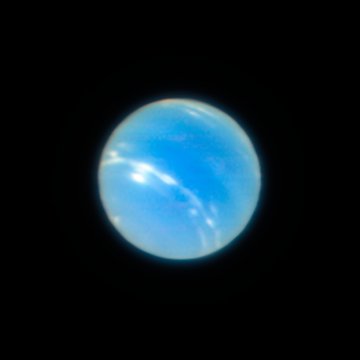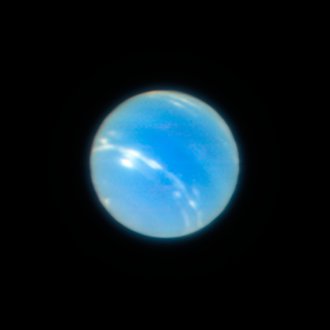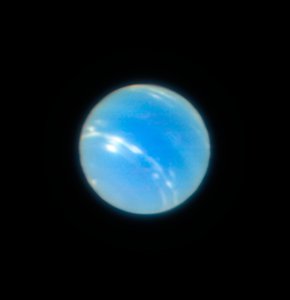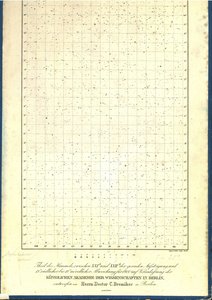175th anniversary of the discovery of Neptune

The outermost planet of our solar system, Neptune, observed using adaptive optics with the MUSE instrument at the Very Large Telescope in Chile.
Credit: AIP/P. Weilbacher23 September 2021 marks the 175th anniversary of the discovery of the most distant planet in the solar system. The Leibniz Institute for Astrophysics Potsdam (AIP) celebrates this event with a lecture by Professor Matthias Steinmetz on the history of the discovery in the series of virtual Babelsberg Starry Nights on YouTube.
Neptune is a bluish shimmering icy gas giant and about four times larger than the Earth. Every 165 years it orbits the Sun as the most distant planet. With binoculars or a telescope, it can be observed well in the constellation Aquarius, but it remains invisible with the naked eye.
The eighth planet of our solar system was discovered by telescope by the scientist Johann Gottfried Galle and his assistant Heinrich Louis d’Arrest on 23 September 1846 at the Berlin Observatory, one of the predecessor institutes of the AIP. Their search for Neptune was based on a prediction by the astronomer Joseph Urbain Le Verrier from the École Polytechnique in Paris. Galle and d’Arrest found the new planet in the immediate vicinity of its predicted location and thus, Le Verrier’s prediction astonished the world. It highlighted the synergy between the theoretical – mathematical – work and empirical – astronomical – observations, but also confirmed the usefulness of charting the skies.
In his lecture on the history of the discovery of Neptune, Professor Matthias Steinmetz reports on the events during the night of discovery, the various efforts of astronomers at the time to find another planet, and the controversies that followed the discovery. The lecture is part of the series “Virtual Babelsberg Starry Nights of AIP” and will be broadcasted starting on Thursday, 23 September 2021 on the YouTube channel “Urknall, Weltall und das Leben”. An episode of the podcast “Die Geschichte Europas” (The History of Europe) by Tobias Jakobi, in which Prof. Matthias Steinmetz is a guest, is also dedicated to the planet Neptune and was released on 20 September. Please note that both the lecture and the podcast are published in German language.
The recently published book “Neptune: From Grand Discovery to a World Revealed”, to which AIP scientist Dr Davor Krajnović contributed a chapter, covers the historical and scientific aspects related to Neptune, including the physics and mathematics required to understand the irregularities in Uranus' motion, and the star charting project whose accurate maps made it possible to identify Neptune as a point in the sky in the first place.
Still today the AIP references to the discovery night in its logo. The stellar constellation in the AIP logo is the one that led to the discovery of Neptune. The stars are directly taken from Bremiker’s Hora XXI of the Berlin Science Academy sky charts, while the round spot among the stars points to the location at which Galle and d’Arrest observed Neptune.
Further information
Virtual Babelsberg Starry Nights
https://www.aip.de/de/babelsberger-sternennaechte/
Podcast episode of “Die Geschichte Europas” with Matthias Steinmetz (in German)
https://geschichteeuropas.podigee.io/46-geu045
Book “Neptune: From Grand Discovery to a World Revealed” with a chapter by Davor Krajnović
https://www.springer.com/en/book/9783030542177
The history behind the AIP logo
https://www.aip.de/en/institute/history/the-history-behind-the-aip-logo/
AIP press release about super-sharp images of Neptune taken with MUSE

The outermost planet of our solar system, Neptune, observed using adaptive optics with the MUSE instrument at the Very Large Telescope in Chile.
Credit: AIP/P. Weilbacher23 September 2021 marks the 175th anniversary of the discovery of the most distant planet in the solar system. The Leibniz Institute for Astrophysics Potsdam (AIP) celebrates this event with a lecture by Professor Matthias Steinmetz on the history of the discovery in the series of virtual Babelsberg Starry Nights on YouTube.
Neptune is a bluish shimmering icy gas giant and about four times larger than the Earth. Every 165 years it orbits the Sun as the most distant planet. With binoculars or a telescope, it can be observed well in the constellation Aquarius, but it remains invisible with the naked eye.
The eighth planet of our solar system was discovered by telescope by the scientist Johann Gottfried Galle and his assistant Heinrich Louis d’Arrest on 23 September 1846 at the Berlin Observatory, one of the predecessor institutes of the AIP. Their search for Neptune was based on a prediction by the astronomer Joseph Urbain Le Verrier from the École Polytechnique in Paris. Galle and d’Arrest found the new planet in the immediate vicinity of its predicted location and thus, Le Verrier’s prediction astonished the world. It highlighted the synergy between the theoretical – mathematical – work and empirical – astronomical – observations, but also confirmed the usefulness of charting the skies.
In his lecture on the history of the discovery of Neptune, Professor Matthias Steinmetz reports on the events during the night of discovery, the various efforts of astronomers at the time to find another planet, and the controversies that followed the discovery. The lecture is part of the series “Virtual Babelsberg Starry Nights of AIP” and will be broadcasted starting on Thursday, 23 September 2021 on the YouTube channel “Urknall, Weltall und das Leben”. An episode of the podcast “Die Geschichte Europas” (The History of Europe) by Tobias Jakobi, in which Prof. Matthias Steinmetz is a guest, is also dedicated to the planet Neptune and was released on 20 September. Please note that both the lecture and the podcast are published in German language.
The recently published book “Neptune: From Grand Discovery to a World Revealed”, to which AIP scientist Dr Davor Krajnović contributed a chapter, covers the historical and scientific aspects related to Neptune, including the physics and mathematics required to understand the irregularities in Uranus' motion, and the star charting project whose accurate maps made it possible to identify Neptune as a point in the sky in the first place.
Still today the AIP references to the discovery night in its logo. The stellar constellation in the AIP logo is the one that led to the discovery of Neptune. The stars are directly taken from Bremiker’s Hora XXI of the Berlin Science Academy sky charts, while the round spot among the stars points to the location at which Galle and d’Arrest observed Neptune.
Further information
Virtual Babelsberg Starry Nights
https://www.aip.de/de/babelsberger-sternennaechte/
Podcast episode of “Die Geschichte Europas” with Matthias Steinmetz (in German)
https://geschichteeuropas.podigee.io/46-geu045
Book “Neptune: From Grand Discovery to a World Revealed” with a chapter by Davor Krajnović
https://www.springer.com/en/book/9783030542177
The history behind the AIP logo
https://www.aip.de/en/institute/history/the-history-behind-the-aip-logo/
AIP press release about super-sharp images of Neptune taken with MUSE
Images
The outermost planet of our solar system, Neptune, observed using adaptive optics with the MUSE instrument at the Very Large Telescope in Chile.
Big screen size [1000 x 1031, 20 KB]
Original size [1208 x 1246, 40 KB]
An excerpt from the Hora XXI sky chart of the Berlin Science Academy completed by Carl Bremiker. Work on the chart started in 1826, but was only completed in 1844 and printed in 1845. It lay untouched until 23 September 1846 when Johann Gottfried Galle and Heinrich Louis d’Arrest used it to discover Neptune, based on the theoretical prediction by Jean Joseph Urbain Le Verrier. The predicted location (square) and the observed location (circle) were noted in pencil, allegedly by Galle, but at some time after the discovery.
Big screen size [1000 x 1414, 280 KB]
Original size [2338 x 3307, 1.0 MB]




